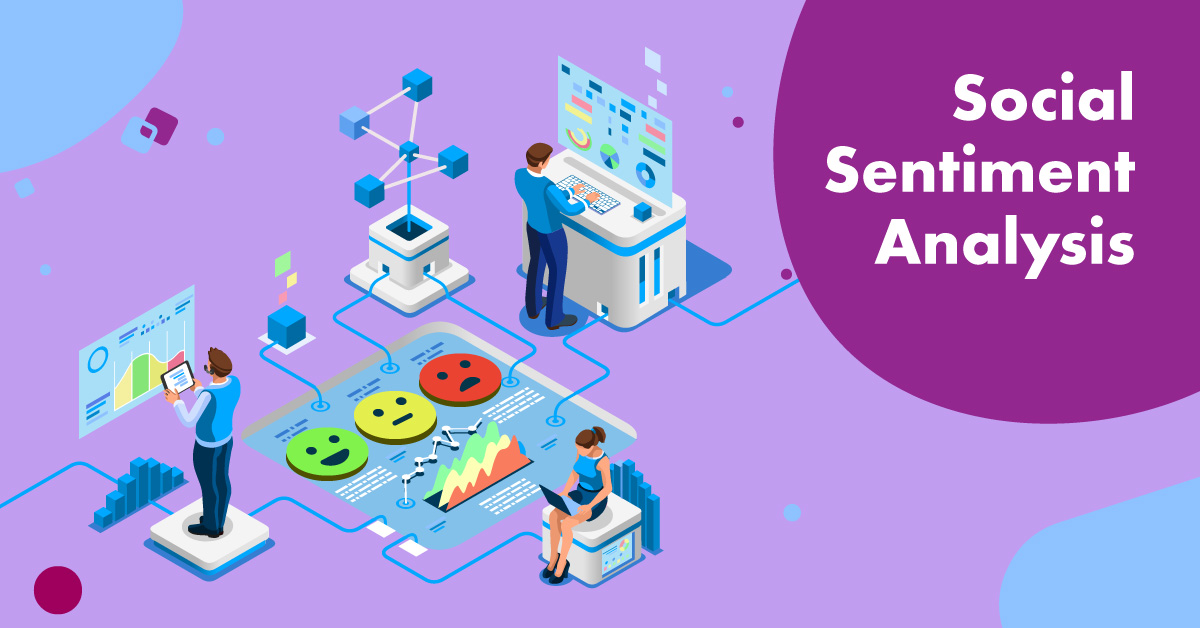In today's fast-paced, digital world, customers have more choices than ever before. With the rise of e-commerce and social media, businesses are facing increasing pressure to understand and respond to customer needs in real-time. Traditional market research methods like surveys and focus groups are no longer enough - companies need new tools and strategies to stay ahead of the curve.Enter sentiment analysis and social listening. By leveraging the power of artificial intelligence (AI), businesses can now gain valuable insights into customer sentiment, preferences, and needs like never before.
Through natural language processing (NLP) and machine learning, companies can analyze vast amounts of text data - from customer reviews to social media posts - to understand how their customers really feel about their products, services, and brand.Social listening takes this one step further by monitoring social media platforms for mentions of a brand, product, or industry. By tracking these conversations, businesses can gain valuable insights into what customers are saying, what they care about, and what their pain points are. This allows companies to stay on top of emerging trends, identify potential issues before they escalate, and engage with customers in real-time.
In this blog post, we'll explore the power of sentiment analysis and social listening, and how AI is revolutionizing the way businesses approach customer understanding. We'll discuss the benefits of these tools, share real-world examples, and provide actionable tips for implementing sentiment analysis and social listening in your own organization. By the end, you'll have a better understanding of how to leverage these powerful technologies to drive customer satisfaction, loyalty, and growth.So, let's dive in and discover how sentiment analysis and social listening can help you better understand and serve your customers in the digital age.
Sentiment Analysis and Social Listening: Using AI to Understand Customer Needs
In today's fast-paced, digital world, businesses are constantly seeking new ways to stay ahead of the curve and better understand their customers. One powerful tool that has emerged in recent years is sentiment analysis and social listening. By leveraging the power of artificial intelligence (AI), companies can now gain valuable insights into customer sentiment, preferences, and needs like never before.
What is Sentiment Analysis?
Sentiment analysis is the process of using natural language processing (NLP) and machine learning techniques to analyze and interpret the emotional tone and sentiment expressed in text data. This can include customer reviews, social media posts, support tickets, and any other form of written communication.By breaking down these texts and assigning positive, negative, or neutral sentiment scores, businesses can gain a deeper understanding of how their customers feel about their products, services, and brand. This information can then be used to make data-driven decisions and improve the customer experience.
The Power of Social Listening
Social listening takes sentiment analysis one step further by monitoring social media platforms for mentions of a brand, product, or industry. By tracking these conversations, businesses can gain valuable insights into what customers are saying, what they care about, and what their pain points are.Social listening allows companies to stay on top of emerging trends, identify potential issues before they escalate, and engage with customers in real-time. It's a powerful tool for building brand loyalty, fostering customer relationships, and staying ahead of the competition.
How AI Enhances Sentiment Analysis and Social Listening
AI is revolutionizing the way businesses approach sentiment analysis and social listening. Machine learning algorithms can process vast amounts of data, identify patterns and trends, and provide insights that would be impossible for humans to uncover on their own.For example, AI-powered sentiment analysis can detect nuances in language, understand context and sarcasm, and provide more accurate sentiment scores than traditional rule-based systems. Social listening tools powered by AI can also monitor multiple platforms simultaneously, track conversations in real-time, and provide actionable insights that can be used to inform business strategy.
The Benefits of Sentiment Analysis and Social Listening
By leveraging sentiment analysis and social listening, businesses can enjoy a range of benefits, including:
Improved customer satisfaction and loyalty
Faster identification and resolution of customer issues
Insights into product development and innovation
Competitive intelligence and market analysis
Targeted marketing and advertising campaigns
Enhanced brand reputation and online presence
In today's highly competitive business landscape, sentiment analysis and social listening are no longer optional – they're essential tools for staying relevant, responsive, and customer-centric. By embracing the power of AI, businesses can gain a deeper understanding of their customers and stay ahead of the curve in an ever-changing world.
Social listening can significantly help businesses improve their customer experience in several ways:
Understanding Customer Needs: Social listening allows businesses to gain valuable insights into their customers' sentiments, preferences, and needs. By monitoring social media channels for customer feedback and mentions, companies can understand what their customers truly think about their products and services, enabling them to tailor their offerings to meet customer expectations.
Enhancing Customer Engagement: By responding promptly to customer comments, questions, or complaints on social media, businesses can show their customers that they genuinely care about their concerns. This engagement not only resolves issues in real-time but also fosters a sense of being valued, leading to increased customer satisfaction and loyalty.
Proactively Addressing Negative Feedback: Social listening helps businesses identify and address negative feedback before it escalates. By promptly responding to complaints or concerns raised on social media, companies can mitigate the impact of negative experiences, retain customer trust, and demonstrate a commitment to resolving issues effectively.
Identifying Opportunities for Improvement: Through social listening, businesses can discover new opportunities for product enhancements, service improvements, or process optimizations. By analyzing customer conversations and feedback, companies can identify pain points, customer desires, and areas for innovation, enabling them to make strategic decisions that align with customer expectations.

Increasing Customer Acquisition: Social listening provides businesses with the opportunity to reach and engage with a broader audience, including potential customers who may not actively engage through traditional feedback channels. By leveraging social media insights, companies can create targeted content, address customer needs, and convert followers into leads and eventually customers, thereby driving customer acquisition and business growth.
In summary, social listening empowers businesses to better understand their customers, engage with them effectively, address issues proactively, identify areas for improvement, and attract new customers. By listening to and acting on customer feedback shared on social media, companies can enhance their customer experience, build stronger relationships, and drive long-term success.
Here are some best practices for implementing effective social listening in a business:
Define Your Scope and Goals
- Clearly define what you want to listen for, including keywords, topics, brand names, product names, competitors, hashtags, etc.
- Determine what results you hope to achieve through social listening, such as understanding customer sentiment, identifying opportunities for improvement, or monitoring industry trends.
Select Relevant Channels to Monitor
- Monitor a broad range of social media channels where your customers are most active, including Facebook, Twitter, Instagram, LinkedIn, forums, blogs, etc.
- Prioritize the channels where your brand is mentioned most frequently to focus your efforts.
Analyze Competitor Activity
-
Monitor what your competitors are doing on social media to identify best practices, successful campaigns, and potential gaps in the market.
- Analyze your competitors' "good buzz" as well as their missteps to gain inspiration for your own social media strategy.
Engage Authentically with Customers
- Respond promptly to customer comments, questions, and complaints to demonstrate that you value their feedback.
- Pay close attention to what customers are saying and adapt your tone and messaging accordingly to build an authentic brand persona.
Share Insights Across the Organization
- Share the insights gained from social listening with teams across the company, including customer service, marketing, product development, and operations.
- Use social listening data to inform broader business strategy and decision-making to improve the customer experience.
Measure Progress and Optimize
- Track key performance indicators (KPIs) over time, such as average social media ratings, sentiment scores, and share of voice.
- Continuously optimize your social listening strategy based on the insights gained and adjust your approach as needed.
Conclusion
In conclusion, the power of sentiment analysis and social listening, fueled by artificial intelligence, offers businesses a transformative way to understand and respond to customer needs in today's digital landscape. By harnessing the insights derived from analyzing customer sentiments, preferences, and feedback on social media platforms, companies can enhance their customer experience, drive loyalty, and stay competitive in a rapidly evolving market.
Through social listening, businesses can proactively engage with customers, address issues in real-time, identify opportunities for improvement, and gain a deeper understanding of their target audience. By listening to what customers are saying on social media, companies can tailor their products, services, and marketing strategies to meet customer expectations and build lasting relationships.As businesses continue to embrace the capabilities of AI-driven sentiment analysis and social listening, they are better positioned to adapt to changing customer needs, anticipate market trends, and drive innovation.
By implementing best practices such as defining clear goals, monitoring relevant channels, engaging authentically with customers, and sharing insights across the organization, businesses can leverage social listening to its full potential and create a customer-centric culture that sets them apart from the competition.In a world where customer experience is a key differentiator, social listening powered by AI is not just a tool but a strategic imperative for businesses looking to thrive in the digital age. By listening, understanding, and acting on customer feedback shared on social media, companies can build stronger connections, drive growth, and ultimately, succeed in meeting the evolving needs of their customers.
Read more :
AI POWERED FRAUD DETECTION AND LOSS PREVENTION
Demand Forecasting with AI: Avoiding Stockouts and Overstocking
Predictive Maintenance for Retail Equipment: Using AI to Prevent Downtime
Optimizing Delivery Routes and Logistics with AI
Augmented Reality (AR) and Virtual Reality (VR) Shopping Experiences powered by AI
AI-driven Visual Search and Recognition for In-Store Shopping
For more information contact : support@mindnotix.com
Mindnotix Software Development Company


 AI-Taxi App
AI-Taxi App AI-Food App
AI-Food App AI-Property Mgmt App
AI-Property Mgmt App AI-CRM
AI-CRM AI-Fantasy App
AI-Fantasy App
 Web Development
Web Development App Development
App Development Business & Startup
Business & Startup Hire Developer
Hire Developer
 Digital Marketing
Digital Marketing Lead-generation
Lead-generation Creative Agency
Creative Agency Branding Agency
Branding Agency Augmented Reality
Augmented Reality Virtual Reality
Virtual Reality Internet of Things
Internet of Things Artificial Intelligence
Artificial Intelligence Blockchain
Blockchain Chatbot
Chatbot



